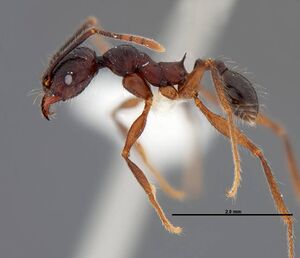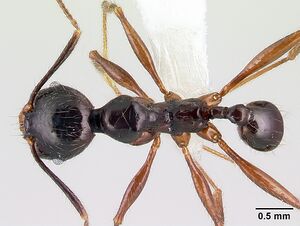Pheidole eowilsoni
| Pheidole eowilsoni | |
|---|---|

| |
| Scientific classification | |
| Kingdom: | Animalia |
| Phylum: | Arthropoda |
| Class: | Insecta |
| Order: | Hymenoptera |
| Family: | Formicidae |
| Subfamily: | Myrmicinae |
| Tribe: | Attini |
| Genus: | Pheidole |
| Species: | P. eowilsoni |
| Binomial name | |
| Pheidole eowilsoni Longino, 2009 | |
Pheidole eowilsoni occurs in mature wet forest. The type series was collected from a nest in a clay bank above a stream. Nocturnal foragers led to a simple hole in a vertical clay bank. The hole led into a tunnel about 1cm diameter. Nest excavation uncovered four chambers containing minor workers, major workers, and brood. One chamber contained a single colony queen. The volume occupied by the nest was about 20cm across and 20cm deep in the bank. One chamber contained what appeared to be an internal trash midden. Among general debris the midden contained nematodes, the remains of a dead Myrmelachista queen, and a few small plant seeds. A second collection was a founding queen with a few minim workers, beneath a stone in a rainforest trail. Minor workers were collected in a pan trap near a stream. (Longino 2009)
Identification
The morphometric profile, sculptural details, and pilosity pattern are unique in this highly distinctive species. Minor worker: the combination of large size, generally shiny mesosoma, dark color, and long, thin, nearly perpendicular propodeal spines are distinctive. Major worker: face foveolate rugulose laterally, grading to smoother and sublucid on vertex lobes, but vertex lobes still sculptured with faint mesh of foveolae and coarse piligerous puncta, versus more uniformly foveolate rugose and not shining (Pheidole vorax) or entirely rugose (Pheidole rhea); scape curved at base, base slightly flattened, about as wide at curvature as maximum width at apex, versus thin at base and less curved (Pheidole astur); antennal club 3-segmented versus 4-segmented (Pheidole dwyeri); color dark brown and dorsal surface of mandible with erect setae versus color orange brown and dorsal surface of mandible lacking erect setae (Pheidole praeses). (Longino 2009)
Distribution
Latitudinal Distribution Pattern
Latitudinal Range: 10.41666667° to 10.31666667°.
| North Temperate |
North Subtropical |
Tropical | South Subtropical |
South Temperate |
- Source: AntMaps
Distribution based on Regional Taxon Lists
Neotropical Region: Costa Rica (type locality), Honduras, Nicaragua.
Distribution based on AntMaps
Distribution based on AntWeb specimens
Check data from AntWeb
Countries Occupied
| Number of countries occupied by this species based on AntWiki Regional Taxon Lists. In general, fewer countries occupied indicates a narrower range, while more countries indicates a more widespread species. |

|
Estimated Abundance
| Relative abundance based on number of AntMaps records per species (this species within the purple bar). Fewer records (to the left) indicates a less abundant/encountered species while more records (to the right) indicates more abundant/encountered species. |

|
Biology
Castes
Worker
Minor
Images from AntWeb
   
| |
| Paratype Pheidole eowilsoni. Worker. Specimen code jtlc000007157. Photographer Stephanie Ware, uploaded by Field Museum. | Owned by FMNH. |
    
| |
| Paratype Pheidole eowilsoni. Worker. Specimen code casent0608880. Photographer Erin Prado, uploaded by California Academy of Sciences. | Owned by CAS. |
Major
Images from AntWeb
   
| |
| Holotype Pheidole eowilsoni. Worker (major/soldier). Specimen code casent0608897. Photographer John T. Longino, uploaded by California Academy of Sciences. | Owned by INBC. |

| |
| Worker (major/soldier). Specimen code casent0608894. Photographer J. Longino, uploaded by University of Utah. | Owned by JTLC. |
Nomenclature
The following information is derived from Barry Bolton's Online Catalogue of the Ants of the World.
- eowilsoni. Pheidole eowilsoni Longino, 2009: 26, fig. 5 (s.w.) COSTA RICA.
Unless otherwise noted the text for the remainder of this section is reported from the publication that includes the original description.
Two collections from 500m elevation on the Barva Transect in Braulio Carrillo National Park and the type series from 800m in the Peñas Blancas Valley have minor workers that are nearly identical to each other. A series of isolated minor workers from 50–500m on the Barva Transect, collected in Winkler and Berlese samples, are tentatively identified as P. eowilsoni but the clypeus lacks a median carina and the ventral margin of the postpetiole is completely flat.
Description
Worker
Minor Measurements (paratype): HL 1.07, HW 0.98, HLA 0.41, SL 1.20, EL 0.18, ML 1.48, PSL 0.19, PMG 0.01, SPL 0.04, PTW 0.16, PPW 0.29, CI 92, SI 122, PSLI 17, PMGI 1, SPLI 4, PPI 184.
Measurements (n=10): HL 0.65-1.13, HW 0.59-1.04, SL 0.92-1.24, CI 89-92, SI 119-156.
Mandible smooth and shining; clypeus smooth and shining with median carina; face shining with very faint mesh of foveolae, only visible in certain lighting conditions; margin of vertex rounded; occipital carina narrow, visible in full face view; scape with abundant subdecumbent setae less than or equal to maximum width of scape; promesonotal groove weakly impressed, promesonotum forming more or less continuous arched convexity; pronotal humerus weakly produced as a quadrate boss; propodeal spines long, thin, nearly perpendicular to dorsal face of propodeum; mesosoma generally smooth and shiny, with very faint foveolate mesh, similar to face, on sides of pronotum, juncture of katepisternum and anepisternum, posterior katepisternum, propodeum, petiole, and postpetiole; 3 strong parallel carinae on metapleural bulla; ventral margin of postpetiole slightly produced anteriorly, forming short step anteriorly; abundant setae on promesonotal dorsum; dorsal (outer) margin of hind tibia with subdecumbent setae and longer suberect setae subequal in length to maximum width of tibia; first gastral tergum smooth and shining; gastral dorsum with abundant, long, suberect setae; color dark red brown with lighter brown legs.
Major Measurements (holotype): HL 2.75, HW 2.58, HLA 0.72, SL 1.32, EL 0.29, ML 2.20, PSL 0.25, PMG 0.00, SPL 0.10, PTW 0.37, PPW 0.80, IHT 0.45, OHT 0.98, CI 94, SI 51, PSLI 9, PMGI 0, SPLI 4, PPI 216, HTI 46.
Mandibles smooth and shiny; medial clypeus smooth and flat with a few longitudinal rugulae laterally, beneath frontal carinae; frontal carina short, forming vertical flange above antennal insertion; face with longitudinal carinulae between frontal carina and compound eye, grading to foveolate rugulose sculpture posteriorly, grading to smoother on vertex lobes, but vertex lobes still sculptured with faint mesh of foveolae and coarse piligerous puncta; medial area between frontal carinae with a sharp median carina and radiating fan of longitudinal carinulae; head with abundant suberect setae projecting from sides of head in face view; scape curved at base, base slightly flattened, about as wide at curvature as maximum width at apex, with abundant erect setae longer than maximum width of scape; hypostomal margin flat; median tooth absent; inner hypostomal teeth stout, closer to midline than to outer hypostomal teeth; promesonotal groove weakly impressed; pronotal humerus strongly developed as blunt cone; propodeal spines present; anterodorsal pronotum and mesonotum with widely-spaced transverse rugulae; side of pronotum with irregular rugulae; katepisternum smooth and shining; lateral propodeum smooth and shining with 3 strong longitudinal carinae on metapleural bulla; dorsal (outer) margin of hind tibia with abundant suberect setae, some longer than maximum width of tibia; pilosity abundant on mesosomal dorsum; postpetiolar sternite foveolate, with pair of anterolateral gibbosities; first gastral tergite smooth and shining with very faint mesh of foveolae, with abundant flexuous suberect setae; color dark red brown.
Type Material
Holotype major worker. Costa Rica, Alajuela: Casa Eladio, Rio Peñas Blancas, 10.31667°N 84.71667°W, ±2000m, 800m, 2 Mar 2008 (J. Longino#6149) [[[INBC|Instituto Nacional de Biodiversidad]], unique specimen identifier CASENT0608897].
Paratypes: major and minor workers. Same data as holotype The Natural History Museum, California Academy of Sciences, EAPZ, ECOSCE, Field Museum of Natural History, Instituto Nacional de Biodiversidad, John T. Longino Collection, Los Angeles County Museum of Natural History, Museum of Comparative Zoology, Musee d'Histoire Naturelle Genève, Instituto de Zoologia Agricola, Museu de Zoologia da Universidade de Sao Paulo, MEL, University of California, Davis, UNAM, ICN, National Museum of Natural History, UVGC.
Etymology
This species is named in honor of E. O. Wilson, whose pioneering work on Pheidole has made the present work possible.
References
- Longino, J.T. 2009. Additions to the taxonomy of New World Pheidole. Zootaxa 2181: 1-90. PDF
References based on Global Ant Biodiversity Informatics
- Longino J. T. 2009. Additions to the taxonomy of New World Pheidole (Hymenoptera: Formicidae). Zootaxa 2181: 1-90.
- Longino J. T. 2013. Ants of Nicargua. Consulted on 18 Jan 2013. https://sites.google.com/site/longinollama/reports/ants-of-nicaragua

